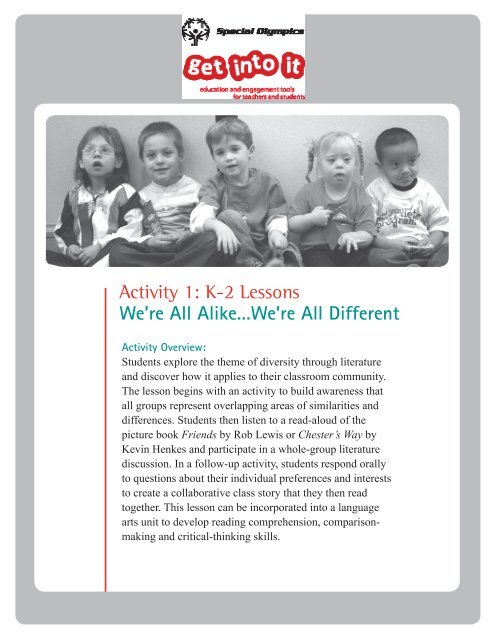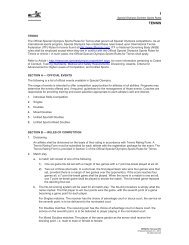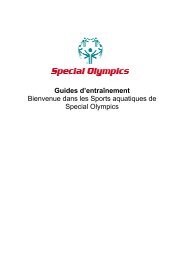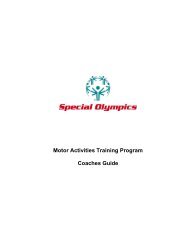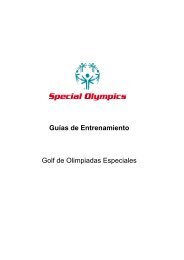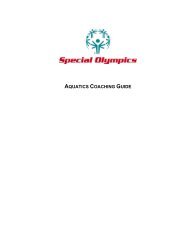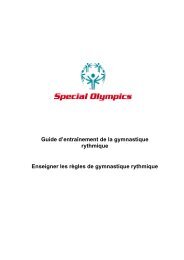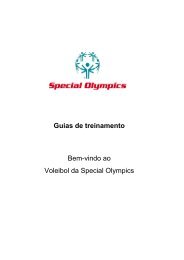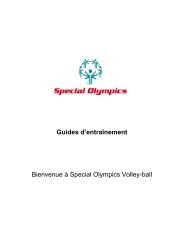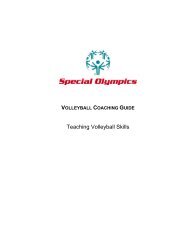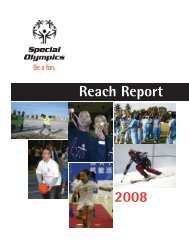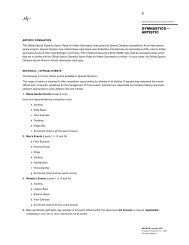Lessons - Special Olympics
Lessons - Special Olympics
Lessons - Special Olympics
You also want an ePaper? Increase the reach of your titles
YUMPU automatically turns print PDFs into web optimized ePapers that Google loves.
Activity 1: K-2 <strong>Lessons</strong><br />
We’re All Alike…We’re All Different<br />
Activity Overview:<br />
Students explore the theme of diversity through literature<br />
and discover how it applies to their classroom community.<br />
The lesson begins with an activity to build awareness that<br />
all groups represent overlapping areas of similarities and<br />
differences. Students then listen to a read-aloud of the<br />
picture book Friends by Rob Lewis or Chester’s Way by<br />
Kevin Henkes and participate in a whole-group literature<br />
discussion. In a follow-up activity, students respond orally<br />
to questions about their individual preferences and interests<br />
to create a collaborative class story that they then read<br />
together. This lesson can be incorporated into a language<br />
arts unit to develop reading comprehension, comparisonmaking<br />
and critical-thinking skills.
Let me win.<br />
But if I cannot<br />
win, let me be<br />
brave in the<br />
attempt.<br />
<strong>Special</strong> <strong>Olympics</strong><br />
Athlete Oath<br />
Activity 1:<br />
We’re All Alike…We’re All Different<br />
Cross-Curricular Connections:<br />
This lesson extends to health units on self-concept and social studies units on<br />
diversity, friendship and community. A shared writing experience helps students<br />
learn more about one another and promotes skills and attitudes needed to build<br />
an inclusive and cooperative classroom community.<br />
Academic Skills Addressed:<br />
• Discovering patterns and relationships among ideas and characteristics;<br />
• Developing reading comprehension strategies through a teacher model of<br />
thinking aloud and asking questions;<br />
• Making connections between literature and real-life experiences — e.g.,<br />
identifying issues of significance within the text and generating open-ended<br />
questions about the text and its personal relevance;<br />
• Participating in writing behaviors and generating ideas for writing by<br />
responding to “What” questions;<br />
• Creating imaginative texts using strategies to contribute to collaborative<br />
projects — e.g., finding relationships among ideas generated by the group and<br />
exploring the ideas of others;<br />
• Conveying meaning through text content and design; and<br />
• Communicating understanding of texts through expressive reading.<br />
Desired Outcomes:<br />
Students will:<br />
• Recognize differences and similarities among classmates.<br />
• Demonstrate comprehension by discussing their reactions to a story and<br />
relating themes in a story to their own lives.<br />
• Identify how individuality within a group provides value.<br />
Time Required:<br />
Two 45- to 60-minute class periods, with additional time for reflection.<br />
2
You don’t have<br />
to be like me to<br />
be my friend.<br />
Activity 1:<br />
We’re All Alike…We’re All Different<br />
Materials Needed:<br />
• Picture books: Friends by Rob Lewis (grades K-1) or Chester’s Way by Kevin<br />
Henkes (grades 1-2)<br />
• Reproducible 1.1, Questions for shared writing activity<br />
• Chart paper and markers<br />
• Index cards or other small pieces of paper (one per student)<br />
• Bag or other container to hold cards<br />
• Large paper and markers (for Reflection activity)<br />
Background:<br />
• Choose one of the picture books about diversity (with the theme “You don’t<br />
have to be like me to be my friend”) that best suits your students’ age and<br />
interests. Review the story ahead of time so that you can read it fluently<br />
and with expression. Flag any pages where you wish to pause your reading<br />
to reinforce students’ connections to the story by providing think-aloud<br />
comments or questions.<br />
• Create and write down 8-10 “Step forward” instructions for the Step Right<br />
Up game in Part One, Steps 1-5. The categories should include a mixture of<br />
internal and external characteristics (e.g., Step right up if you are wearing<br />
sneakers today, …if you have a brother, …if you like sausage on your pizza,<br />
…if you have ever played soccer).<br />
• Write down questions (using Reproducible 1.1 or your own questions) on<br />
small cards for the group writing activity in Part Two, Steps 2-5. Place them in<br />
a bag or other container for students to draw from.<br />
Important Terms:<br />
• alike, different, individual, same, unique<br />
3
PArt One<br />
Tell students<br />
that even<br />
though they are<br />
all alike in many<br />
ways, no one is<br />
exactly the same<br />
as<br />
anyone else.<br />
Activity 1: We ‘re All Alike...We’re All Different<br />
Activity Steps and Suggestions:<br />
1. Introduce a listening game called Step Right Up. Explain that this game is<br />
a fun way for students to learn more about their classmates – the ways in<br />
which they are the same and the ways in which they are different. (Educate)<br />
2. Gather students together to stand side-by-side or, space permitting, in a<br />
large circle. Explain that they will need to listen carefully and respond to<br />
sentences that describe them – their individual traits, experiences, likes and<br />
dislikes – by stepping forward. (Educate)<br />
3. Begin with a simple directive, such as: Step right up if you are wearing<br />
sneakers. (Hint: adopting a carnival barker voice and attitude helps keep<br />
everyone’s attention and makes this activity fun!) Allow time for students<br />
to respond; instruct students to look at the two groups that are created –<br />
the group of students with sneakers and the group of students with other<br />
footwear. Ask students to return to their original spots. (Educate, Motivate)<br />
4. Continue calling out different categories, beginning with external<br />
characteristics (physical descriptions and experiences) and progressing to<br />
internal characteristics (preferences and abilities). Students should step back<br />
after each instruction, so that the individuals who have stepped forward<br />
always represent a different group. Encourage students to look at each<br />
new group formed. Make sure that all students are represented in a number<br />
of statements. Include several statements that include the entire group to<br />
highlight both similarities and differences. (Educate, Motivate)<br />
5. To close the activity, give an instruction that includes everyone (e.g., Step<br />
forward if you are an awesome 2nd grade student in Mrs. Smith’s class!) and<br />
ask students to give themselves and their classmates a hand. (Motivate)<br />
6. Seat students for a whole-group discussion following the experiential<br />
activity. Ask students to share their observations, prompting with questions<br />
such as: Did you learn anything new about your classmates? What’s a good<br />
way to find out if you share the same interests? How much can you tell about<br />
people just by looking at them? Which similarities and differences can you<br />
see and which ones can’t you see? Were the groups that stepped forward<br />
always made up of the same students? Some groups were small and some<br />
groups were large – which did you like being in? What kinds of things do all<br />
your classmates have in common? (Educate, Motivate)<br />
7. Tell students that even though they are all alike in many ways, no one is<br />
exactly the same as anyone else. Our differences make each of us unique.<br />
(Educate)<br />
4
PArt One<br />
Ask students<br />
to recall the<br />
interests and<br />
preferences<br />
of individual<br />
characters...<br />
Activity 1: We ‘re All Alike...We’re All Different<br />
Activity Steps and Suggestions:<br />
8. Begin a read-aloud of the selected picture book. Read the title and show<br />
students the cover, asking them to predict what the story will be about. Tell<br />
students that all the characters are unique – the same in many ways and<br />
different in some ways (just like us!). Ask them to listen for what makes<br />
each character unique. (Educate, Motivate)<br />
9. Model thinking aloud as you read, pausing as appropriate to make comments<br />
or ask questions. For example, for Friends: Hmmm, it sounds like Oscar’s<br />
mother has some good advice about making friends…How do you think<br />
Oscar feels when he sees the other rabbits playing together? For Chester’s<br />
Way: Do you think Chester appreciates Lilly’s help?…Chester has his own<br />
way of doing things – I think he’s unique! (Educate, Motivate)<br />
10. After reading, engage students in a class discussion about how the characters<br />
are unique. Ask students to recall the interests and preferences of individual<br />
characters, turning to illustrations if needed to prompt students’ responses.<br />
Then guide students to identify ways that the story characters learned to<br />
celebrate diversity. How are the characters the same? What things did they<br />
enjoy doing together? How did they learn to celebrate their differences<br />
or uniqueness? How did they learn from one another? How did their<br />
differences make life better for everyone? (Educate, Motivate)<br />
5
PArt tWO<br />
Encourage them<br />
to come up<br />
with something<br />
that celebrates<br />
the diversity of<br />
the group...<br />
Activity 1: We ‘re All Alike...We’re All Different<br />
Activity Steps and Suggestions:<br />
1. Show students the picture book and explain that each of them can contribute<br />
to a story about similarities and differences within their classroom. Ask<br />
students for ideas on what to title this story. List their suggestions on chart<br />
paper. Students may want to title this writing based on the story they read<br />
(e.g., Our Friends or Our Way). (Educate, Motivate)<br />
2. Next, have each student in turn draw a question from the bag (e.g., What<br />
is your favorite dessert?) Assist the student as needed to read the question<br />
aloud to the group. The student responds to the question orally. If necessary,<br />
ask additional questions to prompt a more complete or detailed response.<br />
(Educate, Motivate)<br />
3. As the group watches, repeat and record the student’s oral response in<br />
a complete sentence on chart paper, beginning with the student’s name.<br />
(e.g., Kayla likes vanilla ice cream with butterscotch syrup and chocolate<br />
sprinkles for dessert.) You can ask for a show of hands to see how many<br />
others like the same thing. (Motivate)<br />
4. After each student has answered a question and contributed a sentence, ask<br />
students to brainstorm ideas for an appropriate sentence to end the story.<br />
Encourage them to come up with something that celebrates the diversity<br />
of the group (e.g., Hooray for all of us! or We’re each unique, but we’re<br />
all awesome! or We may be different in many ways, but we’re really all the<br />
same!). Help students vote and tally results to select both the title and final<br />
sentence for their collaborative story. (Educate, Motivate)<br />
5. When the story is complete, point to the words for a choral reading of the<br />
story. Read the story again, this time asking each student to read the sentence<br />
that he or she contributed to the group story. (Educate, Motivate)<br />
6
PHOTO BY: Ryan Eades<br />
Prompt<br />
students to<br />
think creatively<br />
about the<br />
talents,<br />
perspectives,<br />
and experiences<br />
that each<br />
person offers to<br />
the group.<br />
Activity 1:<br />
We’re All Alike…We’re All Different<br />
Reflection:<br />
As a group, develop a concept map based on students in the class. On large<br />
paper, draw a large circle in the center representing the entire class. Don’t label<br />
the circle at this point; it will be filled in at the conclusion of the activity. With<br />
students, brainstorm categories of ways that they are similar and/or unique (i.e.<br />
physical characteristics, likes/dislikes, abilities or talents, experiences, etc.).<br />
Add these categories to the concept map, along with any descriptors students<br />
can think of that are represented in their class. Now go back to the center circle<br />
and ask students to make a list of things their class is able to do as a whole<br />
group because at least one person in the group possesses a particular skill,<br />
interest, or ability. For example, if one person in the class is tall, the whole class<br />
has access to things that may be out of reach for some because the class has that<br />
resource available to them. If one student goes to dance classes, that student<br />
might be able to teach the rest of the class how to dance. Prompt students to<br />
think creatively about the talents, perspectives, and experiences that each person<br />
offers to the group. Before completing the list, ensure that everyone in the class<br />
is represented in at least a few statements.<br />
Suggested Assessment:<br />
• Teacher observation of student responses during group discussions.<br />
• Teacher observation of student responses during interactive read-aloud.<br />
• Evaluate each student’s response to the question: Why are you glad that<br />
everyone in our classroom is unique?<br />
Cross-Curricular Extensions:<br />
Drama<br />
• Students practice reading the collaborative story with expression for a<br />
presentation. Instead of each student reading his or her own contribution, a<br />
classmate reads it. During the reading, the contributor steps forward, listens<br />
and takes a bow. Students present the story to another class as an introduction<br />
to individual students in their class.<br />
7
“Sports play a<br />
critical role in<br />
the health and<br />
development<br />
of all children,<br />
including<br />
those with<br />
disabilities.”<br />
Hon. Ann Veneman,<br />
Executive Director,<br />
UNICEF<br />
Activity 1:<br />
We’re All Alike…We’re All Different<br />
Inclusive Classroom Modifications:<br />
• With the Step Right Up game, having students move into groups is the most<br />
visual and concrete example of group forming. Have peer buddies assist to<br />
help a student with disabilities get into a group. The student can indicate<br />
wanting to join a group by raising a hand, starting to walk, rolling his or her<br />
wheelchair, etc.<br />
• The game can also be played with all students seated. Provide students with a<br />
brightly-colored card taped to a tongue depressor. Print the word “SAME” on<br />
the card and have students hold it up each time a category that applies to them<br />
is called.<br />
• In Part Two, get information from parents in advance about student likes<br />
and dislikes. Record the collaborative story or the piece that the student with<br />
disabilities is going to “read” if memorization and verbalization are issues.<br />
General Extensions and Modifications:<br />
• Divide the class into small groups to read and discuss Our Friend Mikayla,<br />
edited by Kimberly Resh (written and illustrated by a third-grade class about<br />
their classmate Mikayla, who has multiple disabilities. It depicts Mikayla’s<br />
love for cotton candy and Clay Aiken, and how her classmates included her as<br />
a pitcher in kickball.) Students can then write their own class book, using Our<br />
Friend Mikayla as a model, to share with another class.<br />
• Create a visual representation of several categories of classroom differences by<br />
hanging butcher paper with various descriptions around the room (e.g., I have<br />
more than one brother). Students move around the room to read each of the<br />
statements and draw an outline of their hand under any of the statements that<br />
describe them.<br />
• For the writing activity, older students can write their responses to the<br />
questions independently, using phonetic spelling, and add an illustration.<br />
Students’ individual pages can then be laminated and compiled into a class<br />
book to be shared in the reading center or at home with families on a rotational<br />
basis.<br />
Additional Resources:<br />
• Learn more about the authors: Rob Lewis: http://www.rob-lewis.co.uk/ and<br />
Kevin Henkes: http://www.kevinhenkes.com<br />
• Students can watch the animated version of the picture book My Friend<br />
Isabelle (a young boy’s story of his friendship with a girl with Down<br />
syndrome) at: http://www.idso.org/education/EDUCATION.HTML (Click on<br />
Grade K-1 Lesson 3)<br />
8
What is your favorite game or<br />
sport to play?<br />
What vegetable or fruit do you<br />
like best?<br />
What toppings do you like on<br />
your pizza?<br />
What is your favorite TV<br />
program?<br />
What kind of pet do you have<br />
and what is its name?<br />
What is something that makes<br />
you laugh?<br />
What do you like to do most<br />
during recess?<br />
What do you like to do when you<br />
get home from school?<br />
What kind of music do you like<br />
to listen to?<br />
What does your whole family do<br />
together?<br />
What things do you like to<br />
collect?<br />
Reproducible 1.1<br />
Questions for shared writing activity<br />
What do you usually eat for<br />
breakfast?<br />
What is your favorite dessert?<br />
What do you like to do on<br />
Saturdays?<br />
What do you call your<br />
grandmother and grandfather?<br />
What do you want to be when<br />
you grow up?<br />
What is something silly you<br />
like to do?<br />
What makes you sad or afraid?<br />
What is your favorite book?<br />
What is something you do very<br />
well?<br />
What do you usually order at<br />
McDonalds?<br />
What is your favorite thing to<br />
do with your friends?
Activity 2: K-2 <strong>Lessons</strong><br />
the Meaning of Perseverance<br />
Activity Overview:<br />
Students explore the theme of perseverance through read-alouds<br />
of fiction (a fable) and nonfiction, an experiential activity, group<br />
discussions, and collaborative writing activities. The lesson<br />
begins with the identification of the characteristics of a fable<br />
and an interactive reading of The Tortoise and the Hare by<br />
Janet Stevens. Literature discussions focus on the meaning of<br />
perseverance and its applications to students’ lives. Students then<br />
pair up to practice challenging activities and offer encouragement<br />
to one another. Finally, a profile of a <strong>Special</strong> <strong>Olympics</strong> athlete<br />
is read and discussed as a real-life example of perseverance in<br />
action. Students use the <strong>Special</strong> <strong>Olympics</strong> oath as a model to<br />
create their own classroom promise to never give up. This lesson<br />
can be incorporated into a language arts unit to develop reading<br />
comprehension and critical thinking skills, as well as to generate<br />
ideas for authentic writing.
“A rewarding<br />
life is filled with<br />
challenge, so<br />
do not pity<br />
me. Give me a<br />
chance!”<br />
Thomas Gatu, <strong>Special</strong><br />
<strong>Olympics</strong> Athlete<br />
Activity 2:<br />
the Meaning of Perseverance<br />
Cross-Curricular Connections:<br />
This lesson can also be incorporated into the health and physical education<br />
curriculum to promote teamwork and increase behaviors associated with<br />
perseverance.<br />
Academic Skills Addressed:<br />
• Using critical thinking to analyze texts, including identifying and evaluating<br />
multiple perspectives;<br />
• Recognizing relationships between and among texts (fable, nonfiction);<br />
• Making connections between literature and real-life experiences — e.g.,<br />
identifying issues of significance within the text and generating open-ended<br />
questions about the text and its personal relevance;<br />
• Predicting events and meaning in texts before and during interactive reading;<br />
• Discovering patterns and relationships among ideas and characteristics;<br />
• Developing reading comprehension strategies through a teacher model of<br />
thinking aloud and asking questions;<br />
• Creating imaginative texts using strategies to contribute to collaborative<br />
projects — e.g., finding relationships among ideas generated by the group and<br />
exploring the ideas of others; and<br />
• Conveying meaning through text content and design.<br />
Desired Outcomes:<br />
Students will:<br />
• Define perseverance and cite examples of situations that require perseverance.<br />
• Identify specific words and language that is encouraging to others.<br />
• Demonstrate recognition that <strong>Special</strong> <strong>Olympics</strong> athletes often have to work<br />
harder and longer to learn new skills and that they demonstrate perseverance.<br />
Time Required:<br />
Two 45- to 60-minute class periods, with additional time for reflection.<br />
11
“Every person,<br />
regardless<br />
of whatever<br />
different<br />
abilities they<br />
may have, can<br />
contribute, can<br />
be a source of<br />
joy, can beam<br />
with pride<br />
and love.”<br />
Eunice Kennedy Shriver<br />
Activity 2:<br />
the Meaning of Perseverance<br />
Materials Needed:<br />
• Picture book: The Tortoise and the Hare by Janet Stevens<br />
• Reproducible 2.1, <strong>Special</strong> <strong>Olympics</strong> Athlete Cole Cleworth Profile and<br />
Photograph<br />
• Chart paper and marker<br />
• Tape recorder and audiotapes (for Reflection activity)<br />
Background:<br />
Prepare for the read-aloud sessions by familiarizing yourself with the picture<br />
book and <strong>Special</strong> <strong>Olympics</strong> profile story so that you can read them fluently and<br />
with expression. Flag pages in the picture book where you wish to pause your<br />
reading to reinforce students’ connections to the story by providing think-aloud<br />
comments or questions.<br />
Familiarize yourself with the <strong>Special</strong> <strong>Olympics</strong> organization at:<br />
http://www.specialolympics.org<br />
Important Terms:<br />
• attempt, fable, fiction, nonfiction, <strong>Olympics</strong>, perseverance, <strong>Special</strong> <strong>Olympics</strong><br />
PHOTO BY: Ryan Eades<br />
12
PArt One<br />
...every<br />
fable has a<br />
lesson to<br />
teach...<br />
Activity 2: The Meaning of Perseverance<br />
Activity Steps and Suggestions:<br />
1. Before beginning to read aloud from The Tortoise and the Hare, tell students<br />
that you will be reading a special kind of fiction (a story that isn’t true)<br />
called a fable. Spell and write the word fable for students to see. Explain<br />
that a fable is a story in which the characters are usually animals. Show<br />
students the animals pictured on the cover of the book and ask them to<br />
predict whether these characters will behave like real animals or like people.<br />
Why do you think that? (Appropriate responses may be: They’re acting like<br />
people because they’re wearing clothes, they look like cartoons, etc.) Tell<br />
students that fables are about animals that talk and act like human beings.<br />
Also, every fable has a lesson to teach. Ask students if they can figure out<br />
what this hidden lesson is as they listen to the story. (Educate)<br />
2. Pause at appropriate points during the reading to think aloud (e.g., Tortoise’s<br />
friends are very helpful.) or to ask questions (e.g., What do you think will<br />
happen next?). Stop the story before reading the moral at the end – Hard<br />
work and perseverance bring reward. Ask students to predict the lesson of<br />
the fable. (Educate, Motivate)<br />
3. After students suggest possible lessons, read the last line of the book. Spell<br />
and write the word perseverance for students to see. Ask them if they can<br />
figure out what this big word means, based on the story they just heard.<br />
(Appropriate responses include: Not giving up or You keep trying even<br />
though it’s hard). (Educate)<br />
4. Continue the group discussion by asking students to recall the story and<br />
cite examples: What are some ways that Tortoise showed hard work and<br />
perseverance? How was he able to win the race when Hare was a much<br />
faster runner? What things did Tortoise’s friends do to help and encourage<br />
him? Discuss the role that a friend’s support plays in helping us to persevere.<br />
(Educate, Motivate)<br />
13
PArt One<br />
One partner<br />
encourages the<br />
other as he or<br />
she practices<br />
the jump.<br />
Activity 2: The Meaning of Perseverance<br />
Activity Steps and Suggestions:<br />
5. Next, tell students that they will all have a chance to practice perseverance.<br />
Have students work in pairs to learn to do a 180-degree jump turn.<br />
Demonstrate how students should stand with feet shoulder-width apart and<br />
jump while turning their bodies 180 degrees, landing with their feet facing<br />
the opposite direction. If students can do this, ask them to try a 360 degree<br />
jump turn (full turn), landing with their feet facing in the same direction<br />
that they started. One partner encourages the other as he or she practices<br />
the jump. Give the first students several minutes to practice this challenging<br />
jump (gauge the time according to your students’ success and/or frustration)<br />
and signal partners to switch roles. (Motivate)<br />
6. After the activity, gather students together to discuss their experiences,<br />
asking questions such as: How did it feel being unable to accomplish what<br />
seemed like a simple activity? When something is difficult, does it mean that<br />
you can’t do it or that you won’t ever learn to do it? Does practice make a<br />
difference? Did you work hard and persevere, or did you give up? Did you<br />
and your partner encourage one another? How would you feel if someone<br />
made fun of you when you were trying your best? (Motivate)<br />
14
PArt tWO<br />
<strong>Special</strong><br />
<strong>Olympics</strong> is<br />
humanity’s<br />
greatest<br />
classroom,<br />
where lessons<br />
of ability,<br />
acceptance<br />
and inclusion<br />
are taught on<br />
the fields of<br />
competition<br />
by our greatest<br />
teachers - the<br />
athletes.<br />
Activity 2: The Meaning of Perseverance<br />
Activity Steps and Suggestions:<br />
1. Begin a whole group discussion by reviewing the meaning of perseverance.<br />
Help students draw on their own experiences to understand the meaning of<br />
perseverance, especially as it pertains to learning new physical skills (e.g.,<br />
riding a bike or skating) or sports (e.g., baseball, soccer, or skiing). What<br />
activities are hard for you? Have you ever had a hard time learning a new<br />
skill, such as riding a bike or kicking a soccer ball? Did you keep on trying?<br />
Explain that everyone learns to do new things and different people learn in<br />
different ways. Some people need more practice than others to do something<br />
well. (Motivate)<br />
2. With students’ input, briefly review the story of how Tortoise successfully<br />
won the race against Hare, even though he was a slower runner – because<br />
of his perseverance. Ask students if they remember what kind of story<br />
this was (fiction or fable). Tell students that you have another story about<br />
perseverance that is not a fable, but a true story (nonfiction) about a real boy<br />
named Cole (reference Reproducible 2.1). Show students the photograph of<br />
Cole. Explain that in most ways, Cole is like anyone else, but one thing that<br />
makes him special is his perseverance. (Educate)<br />
3. Read the <strong>Special</strong> <strong>Olympics</strong> profile about Cole Cleworth. Stop reading the<br />
profile at the point where it states that Cole spends time in <strong>Special</strong> <strong>Olympics</strong>.<br />
Assess students’ prior knowledge of the <strong>Olympics</strong>. Introduce <strong>Special</strong><br />
<strong>Olympics</strong> as a similar sports program that values each person’s abilities<br />
and unique traits, and holds games in countries all over the world: <strong>Special</strong><br />
<strong>Olympics</strong> includes athletes who might need a longer time to learn sports<br />
than most of us. That means that <strong>Special</strong> <strong>Olympics</strong> athletes have to try<br />
harder and work longer to learn new skills. And that’s perseverance! Invite<br />
students to ask questions at this point. (Educate)<br />
4. Resume reading aloud from the Cole Cleworth profile. When completed, tell<br />
students that all <strong>Special</strong> <strong>Olympics</strong> athletes make the same special promise<br />
to persevere. Write and recite the <strong>Special</strong> <strong>Olympics</strong> Athlete Oath on the<br />
board: Let me win. But if I cannot win, let me be brave in the attempt. Have<br />
students read the oath in unison. Discuss its meaning. What makes a winner?<br />
(Educate)<br />
5. Suggest that students brainstorm ideas for a promise they can make as a<br />
class to help them persevere. Write students’ suggestions on chart paper.<br />
As a group, see if similar ideas can be combined to create several one-totwo<br />
sentence promises that the group can vote on. For example: We’ll root<br />
for one another and always do our best!…We won’t quit until we get it<br />
right! Determine as a group how students want to take the oath (e.g., hands<br />
on hearts or holding two thumbs up) and have students stand and read the<br />
promise together. Display the promise prominently in the classroom as a<br />
daily reminder that your class never gives up. (Motivate, Activate)<br />
15
Tell students to<br />
imagine they<br />
are reporters<br />
who want<br />
to interview<br />
students about<br />
a time when<br />
they have<br />
persevered when<br />
something was<br />
difficult.<br />
Activity 2:<br />
the Meaning of Perseverance<br />
Reflection<br />
Tell students to imagine they are reporters who want to interview the other<br />
students about a time when they have persevered when something was difficult.<br />
During group time, turn on the tape recorder and ask students reflective<br />
questions about this experience. Start by having the students briefly explain<br />
the difficult experience. Other questions may include what students liked best<br />
about the experience, what they liked least, what it was that kept them going<br />
even when it got difficult, what they learned, and how this experience differed<br />
from doing something that was easy to do. Tape-record this conversation. Play<br />
the conversation back and ask students if any information is missing. Then have<br />
groups of students take turns playing reporter and respondent. What were the<br />
most important lessons they learned about perseverance? What did they learn<br />
from hearing about how other students handled adversity? Summarize students’<br />
comments. 1<br />
Suggested Assessment:<br />
• Teacher observation of student responses during group discussions.<br />
• Teacher observation of student responses during interactive read-aloud.<br />
Cross-Curricular Extensions:<br />
Math / Language Arts<br />
• Depending on students’ skills, conduct a group lesson or have students work in<br />
pairs to compare and record the traits of the characters Tortoise and Hare from<br />
the story. Sort these characteristics using a Venn diagram. Students receive<br />
further independent practice in categorizing imaginary animals using Logic<br />
Zoo on the PBSKids website at:<br />
http://pbskids.org/cyberchase/games/logic/logic.html<br />
Inclusive Classroom Modifications:<br />
• For inclusive classrooms in which students have gross motor difficulties,<br />
provide other types of challenges to help students experience perseverance.<br />
These may include tasks such as students writing the word perseverance ten<br />
times or completing desk work while balancing beanbags on their heads.<br />
• In Part One, Step 2, ask questions with only two answers. For example: Who<br />
do you think is going to win – the tortoise or the hare? Follow up with the<br />
open-ended question, Why?<br />
• In Part One, Step 5, simplify the 180-degree jump to jumping over a “creek,”<br />
marked on the floor with two lines.<br />
1 Adapted with permission from Connecting Thinking and Action: Ideas for Service-Learning<br />
Reflection. Denver: RMC Research, 2003.<br />
16
“If people<br />
would believe in<br />
us like <strong>Special</strong><br />
<strong>Olympics</strong> and<br />
see what we<br />
can do, they<br />
would be<br />
amazed. My<br />
ambition in<br />
life is to turn<br />
‘no’ into ‘yes’.<br />
If someone<br />
says I can’t do<br />
something, I<br />
want to prove<br />
I can.”<br />
Suzanne O’Moore,<br />
<strong>Special</strong> <strong>Olympics</strong><br />
Australian Athlete<br />
Activity 2:<br />
The Meaning of Perseverance<br />
• During the Reflection, use pictures of facial expressions to clarify feelings.<br />
Have pre-written questions ready for those students who have difficulty<br />
reading and writing, and allow them to draw their answer or have a buddy<br />
write it for them.<br />
• If choosing to implement the cross-curricular extension, replace the Venn<br />
diagram with a puzzle from a page of the book. (Copy, laminate, and then cut<br />
the page.) Alternatively, have students match letters to pre-selected words.<br />
General Extensions and Modifications:<br />
• Create a “Fables” section in your classroom reading corner for single fable<br />
picture books such as: Turtle’s Race with Beaver by Joseph and James<br />
Bruchac; How Chipmunk Got His Stripes by Joseph and James Bruchac; The<br />
Tortoise and the Hare: An Aesop’s Fable by Angela McAllister; Town Mouse,<br />
Country Mouse by Jan Brett; The Lion and the Mouse by Bernadette Watts;<br />
and The Boy Who Cried Wolf by B. G. Hennessy.<br />
• Include picture books in the classroom reading corner about sports figures<br />
who have demonstrated perseverance. Examples include: How to Train with<br />
a T. Rex and Win 8 Gold Medals by Michael Phelps; A Picture Book of Jackie<br />
Robinson by David A. Adler; A Picture Book of Jesse Owens by David A.<br />
Adler; and Wilma Unlimited: How Wilma Rudolph Became the World’s Fastest<br />
Woman by Kathleen Krull.<br />
• Set up multiple stations for presenting challenging physical tasks in the gym<br />
or on the playground. Allow time for students to rotate between tasks, such<br />
as throwing a beanbag at a small target from a long distance, tossing, and<br />
catching a ball using the non-dominant hand, and walking a designated course<br />
(or balance beam) backwards.<br />
Additional Resources:<br />
• Fiction: A Very <strong>Special</strong> Athlete by Dale Bachman Flynn<br />
• Fiction: A <strong>Special</strong> Day for Lucas by Kathie Mowrer Fields<br />
• Nonfiction: <strong>Special</strong> <strong>Olympics</strong> by Mike Kennedy<br />
17
Reproducible 2.1<br />
<strong>Special</strong> <strong>Olympics</strong> Athlete Cole Cleworth<br />
MEET SPECIAL OLYMPICS ATHLETE:<br />
COLe CLeWOrtH<br />
Cole Cleworth is 10 years old and lives in a small city in<br />
Wisconsin. He likes drawing, singing, bowling, cross-country<br />
skiing and track and field. He is also active in his church. In<br />
many ways Cole is like any other child his age. But Cole has<br />
Down syndrome. Not that that stops him, his family or his<br />
school from doing just about anything. It just makes things a<br />
little harder.<br />
Having Down syndrome is just something that makes him a<br />
little different, the way you have brown eyes and I have blue<br />
ones. Down syndrome makes him more flexible in his joints<br />
than most kids and also gives his eyes a different shape. It also<br />
makes him learn more slowly. But he can do everything you<br />
do, just a little more slowly. He likes all the same things other<br />
kids do and he’s a great friend. And by the way, you can’t<br />
catch Down syndrome, but once you have it, you’ll always<br />
have it.<br />
Teacher note: Allow children to ask question here.<br />
Cole spends a lot of his time in <strong>Special</strong> <strong>Olympics</strong>. He has<br />
won medals in all his sports. He was especially excited when<br />
he received his first gold medal. He won it for cross-country<br />
skiing.<br />
Cole is smaller than most athletes his age, but this does not stop him from trying. He tries any sport he is asked<br />
to try and gives it his all. When running in his first race at competition, he ran down the track with a huge smile<br />
on his face and waved to the crowd. That caused the crowd to cheer more and he smiled even bigger. When he<br />
gets on cross-country skis, he moves very quickly. At times he falls, but he jumps right back up and keeps going.<br />
Cole always wants to try new things. He isn’t afraid. All in all, Cole is just like many children his age—except<br />
for having Down syndrome. But if you know Cole, there is nothing “down” about him. He can light up the day<br />
with his smile and he brings joy to those who know him.
Activity 3: K-2 <strong>Lessons</strong><br />
Go for the Gold!<br />
Activity Overview:<br />
This lesson centers on the word “Gold,” its relevance to<br />
<strong>Special</strong> <strong>Olympics</strong> (gold medals), and the character trait of<br />
caring (hearts of gold and the Golden Rule). Students listen<br />
to a story about a <strong>Special</strong> <strong>Olympics</strong> athlete and discuss the<br />
importance of the caring and encouraging individuals who<br />
help support him/her. Students generate a written list of<br />
encouraging words and phrases, which they use to create<br />
posters to share with their school community. Students then<br />
apply knowledge about caring words and actions to identify<br />
examples within their classroom, and practice giving and<br />
receiving compliments and encouragement appropriately.<br />
This lesson can be incorporated into a language arts unit to<br />
develop reading comprehension and critical thinking skills,<br />
as well as to generate ideas for authentic writing.
“I was once<br />
very shy and<br />
not willing<br />
to talk with<br />
others. <strong>Special</strong><br />
<strong>Olympics</strong><br />
changed my<br />
life and my<br />
love of sports<br />
and helped me<br />
achieve all this<br />
unimaginable<br />
success.”<br />
Xu Chuang, <strong>Special</strong><br />
<strong>Olympics</strong> China Athlete<br />
and International Global<br />
Messenger<br />
Activity 3:<br />
Go for the Gold!<br />
Cross-Curricular Connections:<br />
This lesson can be incorporated into social studies units on diversity, friendship,<br />
and community. Students learn to recognize and affirm positive character traits<br />
in themselves and others, and develop skills and attitudes needed to build an<br />
inclusive and cooperative community. It also extends into the art curriculum,<br />
where students use writing, drawing, and painting skills to create posters for<br />
display in public areas of the school.<br />
Academic Skills Addressed:<br />
• Making connections between literature and real-life experiences — e.g.,<br />
identifying issues of significance within the text and generating open-ended<br />
questions about the text and its personal relevance;<br />
• Using critical thinking to analyze texts;<br />
• Using strategies for analyzing and understanding the meanings of words and<br />
phrases;<br />
• Using words and phrases that are appropriate to context;<br />
• Developing ideas using creative thinking, problem posing, and problem<br />
solving strategies;<br />
• Discovering patterns and relationships among ideas and characteristics;<br />
• Creating imaginative texts using strategies to contribute to collaborative<br />
projects — e.g., finding relationships among ideas generated by the group and<br />
exploring the ideas of others; and<br />
• Conveying meaning through text content and design.<br />
Desired Outcomes:<br />
Students will:<br />
• Demonstrate recognition that <strong>Special</strong> <strong>Olympics</strong> athletes need encouragement<br />
from caring fans and other individuals.<br />
• Identify the value and meaning of caring as a character trait.<br />
• Use encouraging words and demonstrate caring actions within their classroom<br />
and school community.<br />
• Give and receive compliments and encouragement appropriately.<br />
Time Required:<br />
Three 45- to 60-minute class periods<br />
20
“Go for the<br />
gold, we<br />
keep telling<br />
our athletes.<br />
But it is the<br />
volunteers<br />
of <strong>Special</strong><br />
<strong>Olympics</strong> who<br />
walk away<br />
with the gold,<br />
richer for the<br />
experience.”<br />
L. Tusak, <strong>Special</strong><br />
<strong>Olympics</strong> coach and<br />
volunteer<br />
Activity 3:<br />
Go for the Gold!<br />
Materials Needed:<br />
• Craft materials for a Heart of Gold medal (e.g., wooden craft store heart,<br />
ribbon, gold paint)<br />
• Chart paper and marker<br />
• Reproducible 3.1, <strong>Special</strong> <strong>Olympics</strong> Gold Medal<br />
• Reproducible 3.2, My Brother’s <strong>Special</strong> <strong>Olympics</strong> Medal<br />
• Construction paper or poster board, enough for every two students<br />
• Crayons, markers, or paints for creating posters<br />
• Grab bag or box (for Reflection activity)<br />
• Small items, such as a mirror, pencil, ball, glasses, etc. (for Reflection activity)<br />
Background:<br />
• Before beginning this lesson, familiarize yourself with My Brother’s <strong>Special</strong><br />
<strong>Olympics</strong> Medal (Reproducible 3.2) so that you can read it fluently and with<br />
expression. Flag any pages or passages where you wish to pause your reading<br />
to reinforce students’ connections to the story by providing think-aloud<br />
comments or questions.<br />
• Construct a Heart of Gold medal that is fairly durable and can easily slip over<br />
a student’s head and be worn around the neck. (Suggestion: Use gold spray<br />
paint on a wooden craft store heart and thread a ribbon through it.)<br />
Important Terms:<br />
• caring, encouragement, fan, Golden Rule, heart of gold, valuable<br />
21
PArt One<br />
Why do people<br />
want gold?<br />
What makes<br />
gold valuable?<br />
Activity 3: Go for the Gold!<br />
Activity Steps and Suggestions:<br />
1. Write the word GOLD on chart paper to arouse students’ curiosity. Ask<br />
students what they think of when they read this word. Why do people want<br />
gold? What makes gold valuable? Show Reproducible 3.1, the <strong>Special</strong><br />
<strong>Olympics</strong> Gold Medal, and pass it around so students can read the words<br />
<strong>Special</strong> <strong>Olympics</strong>. Why is this medal made of gold? What does a gold medal<br />
mean? (Educate)<br />
2. Read My Brother’s <strong>Special</strong> <strong>Olympics</strong> Medal (Reproducible 3.2). Pause<br />
periodically to reflect on the characters’ feelings. How do you think Ben feels<br />
when the kids tease him? How does Angie feel? (Educate)<br />
3. Follow the oral reading with a group discussion: In what ways are Angie and<br />
Ben different? In what ways are they the same? Why is soccer and <strong>Special</strong><br />
<strong>Olympics</strong> important to Ben? How do the soccer team members support one<br />
another? How do the fans encourage the team? (Educate)<br />
4. Continue the discussion by asking students to role play the part of fans in the<br />
stands at Ben’s soccer game. Present various scenarios, asking students what<br />
they would say (or shout) if:<br />
– Ben looks tired; he slows his running and looks like he is ready to<br />
give up.<br />
– Ben and his team win the competition.<br />
– Ben and his team lose the competition.<br />
– Ben is crying and says that he never wants to play soccer again.<br />
Responses might include: I know you can do it!…You’re doing great – keep<br />
playing!...Way to go!…Congratulations!...That was a great try!…Good<br />
game!…It’s how you play the game that counts...Don’t give up! (Motivate)<br />
5. Write these encouraging words and comments on chart paper as students<br />
shout them out. (Remind students that these are things that they can say to<br />
themselves too!) Display this list in the classroom for reference. (Motivate)<br />
6. Ask students to think about ways we can share words of encouragement<br />
in addition to saying them (e.g., notes, greeting cards, emails). How can<br />
we share words of encouragement with other students in our own school?<br />
(Motivate)<br />
7. Instruct students to work in cooperative pairs to create an illustrated poster,<br />
using the listed words and statements as writing models. Remind students<br />
to use encouraging words with each other as they decide what words they<br />
will write and what pictures they will draw/paint to create their posters.<br />
When completed, encourage students to share their posters with classmates.<br />
Later, students can help hang their posters in public areas of the school to<br />
encourage others and promote caring. (Activate)<br />
22
PArt tWO<br />
Treating others<br />
the same way<br />
we want to<br />
be treated is a<br />
great way to<br />
show caring.<br />
Activity 3: Go for the Gold!<br />
Activity Steps and Suggestions:<br />
1. Just as you did in the last session, write the word GOLD on chart paper<br />
to arouse students’ curiosity. Ask students if they have ever heard the<br />
expression – heart of GOLD – and write the phrase. Does it mean that<br />
someone’s heart is really made of gold? Through questioning, help students<br />
discover that to have a heart of GOLD is to have an encouraging and caring<br />
nature, which is a valuable thing – like gold. (Educate)<br />
2. Extend the discussion to focus on the character trait of caring: How do<br />
you know if someone cares about you? How do you feel when people show<br />
that they care about you? How do you feel when you do something caring<br />
for someone else? With students’ help, create a definition for the word<br />
caring and write it on the chart paper (e.g., giving encouragement; showing<br />
kindness and concern for the well-being of others). (Educate)<br />
3. If you previously implemented Activity 1, remind students how they’ve<br />
learned that they are all the same in some ways and different in other ways.<br />
Conduct a survey about students’ likes and dislikes by presenting various<br />
ways that people show caring: Raise your hand if you like when someone<br />
smiles at you...if you like when someone gives you a compliment…if you<br />
like when someone invites you to play with him or her…if you like when<br />
someone high-fives you. All students will undoubtedly raise their hands. Ask<br />
appropriate questions to help students make the connection that everyone<br />
likes to be treated in the same way – and everyone likes it when others show<br />
that they care about them. (Educate)<br />
4. Once again, write the word GOLD. Tell students that you know a rule that<br />
has the word gold in it. What might the word ‘gold’ tell you about the rule?<br />
Would it be a valuable rule? Assess students’ prior knowledge of the Golden<br />
Rule. Model turning the word GOLD into the word GOLDEN and write the<br />
rule as students watch: Treat others the way you want to be treated. Recite<br />
the rule together. Remind students that even if people are different in some<br />
ways, they want to be treated the same way you do. Treating others the<br />
same way we want to be treated is a great way to show caring. (Educate,<br />
Motivate)<br />
5. Show students the special Heart of Gold medal. Can they guess what this<br />
medal is awarded for? Have students sit in a circle for a medal ceremony.<br />
Present the medal to one student to wear and model giving him or her an<br />
appropriate compliment, citing something that student has said or done that<br />
demonstrates kindness or caring: Diondre, I really liked the way you offered<br />
to help carry the chart over for our group meeting. The medal is then passed<br />
to each student in turn and classmates compliment that student. You may<br />
also need to model and reinforce how to receive compliments appropriately.<br />
If students are highly motivated by this circle of caring, make it an ongoing<br />
weekly activity. (Motivate, Activate)<br />
23
“I’ve learned<br />
so much from<br />
Adam and<br />
I’m sure he’s<br />
learned some<br />
from me. If<br />
you take the<br />
time to make<br />
them your<br />
friend, they’re<br />
the same as<br />
everyone else.”<br />
Tommy Oreste, <strong>Special</strong><br />
<strong>Olympics</strong> Youth Summit<br />
participant<br />
Activity 3:<br />
Go for the Gold!<br />
Reflection:<br />
Using the concept of a grab bag, place a number of items related to caring<br />
about and encouraging others in a big bag or box that conceals their identity,<br />
but allows students to reach in and explore objects. For example, a mirror<br />
might prompt kind words about a person’s appearance or encourage a smile. A<br />
pencil or sheet of paper might suggest encouraging remarks about something<br />
a person has written. A ball might conjure thoughts about a student’s play in a<br />
game of baseball. Glasses may encourage appreciative words about a student’s<br />
perspective or way of looking at things. Taking turns, have students reach in and<br />
feel an object, use descriptive language to describe it to their classmates, and try<br />
to guess what the object is. Take out the object and discuss what the object is and<br />
how it relates to being kind, caring, and encouraging toward their classmates.<br />
Suggested Assessment:<br />
• Teacher observation of student participation and responses during group<br />
discussions and during cooperative activity.<br />
• Work samples: Posters<br />
• Teacher observation of student responses during circle of caring activity.<br />
• Student reports of observed acts of caring presented during circle of caring<br />
activity.<br />
Cross-Curricular Extensions:<br />
Social Studies<br />
• Extend the giving of compliments and encouragement outside the classroom.<br />
Engage students in a discussion about the caring people throughout<br />
their school and the hard work that they do. Have students write notes to<br />
compliment or encourage cafeteria workers, office staff, and custodians.<br />
Reflect on the positive impact that these notes make on your school<br />
community.<br />
Inclusive Classroom Modifications:<br />
• Ask the physical education teacher to discuss and play out “watching a game<br />
and being fans.” Have students take turns playing a game or doing an activity<br />
and then being the observer or fan. This can be done in pairs or in larger<br />
groups. The physical education teacher can write down the encouraging words<br />
used, and send the list back to the classroom.<br />
• Explore ways other than words to express encouragement: thumbs up, smiling,<br />
applause, pat on the back, hug, etc.<br />
• In Part One, Step 7, allow pictures, stickers, and stamps on the posters.<br />
• If you choose the Caring Spies extension (below), reduce the time period.<br />
(One week may be too long for some students.) Students can hand out<br />
stamps, stickers, or small notes immediately when noticing a caring act. This<br />
immediate connection may better reinforce the actions among some students.<br />
24
Instead of<br />
giving and<br />
receiving<br />
compliments<br />
as a group,<br />
classmates<br />
can be<br />
Caring Spies.<br />
Activity 3:<br />
Go for the Gold!<br />
General Extensions and Modifications:<br />
• Have students watch a 60-second PSA that depicts special athletes who<br />
exemplify hearts of gold at:<br />
http://www.youtube.com/watch?v=Ybmo58bTRj0<br />
After all students have seen the video, conduct large or small group<br />
discussions to reflect on questions such as: How do these athletes show<br />
caring? What do you think the fans were thinking? Why did the fans applaud?<br />
Who should the gold medal go to? What do the words ‘true victory’ mean? Is<br />
that different than winning? If you were one of the fans, what would you say to<br />
these runners?<br />
• Instead of giving and receiving compliments as a group, classmates can be<br />
Caring Spies. Classmates draw a name at the beginning of the week, but do<br />
not reveal it. During the week, whenever they spy their assigned classmate<br />
doing something caring, students write an anonymous compliment on an index<br />
card. Compliments can be “delivered” on Friday afternoons.<br />
• Share the story of Terry Fox (www.terryfox.org), a model of activism and<br />
engagement. Ask students: What are some ways Terry shows he cares? Does<br />
he exemplify a heart of gold? What can you learn from Terry?<br />
Additional Resources:<br />
• PSA video: http://www.youtube.com/watch?v=Ybmo58bTRj0<br />
• Song “I Think You’re Wonderful” from Teaching Peace by Red Grammer:<br />
http://www.amazon.com/I-Think-Youre-Wonderful/dp/B00119V6W0<br />
• Fiction: A Very <strong>Special</strong> Athlete by Dale Bachman Flynn<br />
• Fiction: A <strong>Special</strong> Day for Lucas by Kathie Mowrer Fields<br />
• Nonfiction: <strong>Special</strong> <strong>Olympics</strong> by Mike Kennedy<br />
• Be a Fan PSA video (30 sec):<br />
http://www.facebook.com/video/video.php?v=26663070286<br />
• 3 Word video (2:45):<br />
http://www.facebook.com/video/video.php?v=135014990286<br />
• Inclusion in Panama video (2:29):<br />
http://www.facebook.com/video/video.php?v=126509085286<br />
• Running in Africa video (2:37):<br />
http://www.facebook.com/video/video.php?v=126508045286<br />
• Eunice Kennedy Shriver Tribute video (3:51):<br />
http://www.facebook.com/video/video.php?v=220804995286<br />
• “R word” speech by Soeren (9:52):<br />
http://www.facebook.com/video/video.php?v=149050755286<br />
• Family Inspiration video (2:34):<br />
http://www.facebook.com/video/video.php?v=129922390286<br />
• See the Athlete 1st video (31 sec): http://www.youtube.com/<br />
watch?v=bv4fzNYxstc<br />
• Joe Jonas Run for <strong>Special</strong> <strong>Olympics</strong> video (2:05): http://community.<br />
specialolympics.org/_Joe-Jonas-iWIn-Fun-Run-for-<strong>Special</strong>-<strong>Olympics</strong>/<br />
video/893530/82244.html<br />
25
Reproducible 3.1<br />
The <strong>Special</strong> <strong>Olympics</strong> Gold Medal
Reproducible 3.2<br />
My Brother’s <strong>Special</strong> <strong>Olympics</strong> Medal
Activity 4: K-2 <strong>Lessons</strong><br />
Be a Fan!<br />
Activity Overview:<br />
This lesson builds on the previous lessons. Whether you have<br />
completed one or all three of them, this lesson sets a process in motion<br />
for implementing a group-based service-learning experience that<br />
actively engages students in meaningful, relevant service activities.<br />
Following a classroom visit from a <strong>Special</strong> <strong>Olympics</strong> athlete, coach,<br />
representative, or volunteer, students identify a need in their school or<br />
community. The teacher guides students as they design a group service<br />
project that celebrates diversity, promotes teamwork, or encourages<br />
<strong>Special</strong> <strong>Olympics</strong> athletes or peers with special needs in their school<br />
or community. Students use a variety of speaking, writing, drama,<br />
and art skills to plan and implement this ongoing service-learning<br />
experience. Students reflect on the outcomes/impacts of the experience<br />
on themselves and their community and celebrate their success.<br />
This lesson can be incorporated into a language arts unit to develop<br />
purposeful speaking and authentic reading and writing skills.
“Playing sports<br />
with <strong>Special</strong><br />
<strong>Olympics</strong> has<br />
given me the<br />
opportunity to<br />
express myself<br />
like many other<br />
athletes...”<br />
Anthony Green, <strong>Special</strong><br />
<strong>Olympics</strong> Athlete<br />
Activity 4:<br />
Be a Fan!<br />
Background on Service-Learning (NYLC Standards)<br />
The National K-12 Service-Learning Standards for Quality Practice guide<br />
educators in their integration of service-learning experiences, including those<br />
for K-12 students. This lesson provides a number of suggestions for servicelearning<br />
experiences that extend from any of the previous lessons and capitalize<br />
on the classroom visit from a participant in the <strong>Special</strong> <strong>Olympics</strong> movement.<br />
The Standards are at the core of the service-learning experiences outlined in this<br />
lesson. They include:<br />
1. Service-learning actively engages participants in meaningful and personally<br />
relevant service activities.<br />
2. Service-learning is intentionally used as an instructional strategy to meet<br />
learning goals and/or content standards.<br />
3. Service-learning incorporates multiple challenging reflection activities that<br />
are ongoing and that prompt deep thinking and analysis about oneself and<br />
one’s relationship to society.<br />
4. Service-learning promotes understanding of diversity and mutual respect<br />
among all participants.<br />
5. Service-learning provides youth with a strong voice in planning,<br />
implementing and evaluating service-learning experiences with guidance<br />
from adults.<br />
6. Service-learning experiences are collaborative, mutually beneficial and<br />
address community needs.<br />
7. Service-learning engages participants in an ongoing process to assess the<br />
quality of implementation and progress toward meeting specified goals, and<br />
uses results for improvement and sustainability.<br />
8. Service-learning has sufficient duration and intensity to address community<br />
needs and meet specified outcomes.<br />
For more information on service-learning and how to implement servicelearning<br />
experiences in your classroom, review the Service-Learning<br />
Instructional Planning Guide available for download at:<br />
https://getintoit.specialolympics.org/educators<br />
66
Recognize the<br />
role that <strong>Special</strong><br />
<strong>Olympics</strong><br />
plays within<br />
your own<br />
community.<br />
Activity 4:<br />
Be a Fan!<br />
Cross-Curricular Connections:<br />
This lesson extends to health units on self-concept and social studies units<br />
on diversity, friendship, and community. In this lesson students explore civic<br />
responsibility, begin to understand their roles as citizens, and develop skills and<br />
attitudes needed to build an inclusive and cooperative community.<br />
Academic Skills Addressed (specific service-learning experiences will<br />
address more):<br />
• Posing reasoned questions drawn from previous learning and from personal<br />
experiences;<br />
• Engaging in an inquiry process;<br />
• Developing ideas using creative thinking, problem posing, and problem<br />
solving strategies;<br />
• Discovering patterns and relationships among ideas in a collaborative process;<br />
• Receiving and exploring the ideas of others; and<br />
• Conveying meaning through text content and design.<br />
Desired Outcomes:<br />
Students will:<br />
• Recognize the role that <strong>Special</strong> <strong>Olympics</strong> plays within their own community.<br />
• Identify actions that support and encourage <strong>Special</strong> <strong>Olympics</strong> athletes and<br />
peers with special needs.<br />
• Use speaking, writing, drama, and art skills in meaningful ways to meet a need<br />
related to diversity and inclusion in their school or community.<br />
Time Required:<br />
Two 30-minute class periods to introduce the service-learning process, linked<br />
with a classroom visit from a <strong>Special</strong> <strong>Olympics</strong> guest. Time requirements for<br />
planning, implementation, and evaluation of the service-learning experience will<br />
vary.<br />
67
Playing<br />
together hand<br />
in hand<br />
Around the<br />
world with a<br />
friendship band<br />
Proud and<br />
strong, unified<br />
we stand<br />
Let’s sing a<br />
song of love.<br />
Excerpt from<br />
Song of Love<br />
<strong>Special</strong> <strong>Olympics</strong> Fan<br />
Community<br />
Activity 4:<br />
Be a Fan!<br />
Materials Needed:<br />
• Blank audio CD and CD player<br />
• Reproducible 4.1, Song of Love lyrics<br />
• Chart paper and marker<br />
Background:<br />
• Well in advance of the lesson, go to:<br />
http://www.specialolympics.org/program_locator.aspx for contact information<br />
regarding a <strong>Special</strong> <strong>Olympics</strong> program near you. Make arrangements for a<br />
<strong>Special</strong> <strong>Olympics</strong> athlete, coach, representative, or volunteer to visit your<br />
classroom. If it’s not possible to have a guest speaker, explore the content on<br />
the following website to find appropriate video material to share with your<br />
class:<br />
www.specialolympics.org/community<br />
• Download the song from: http://community.specialolympics.org/_SONG-OF-<br />
LOVE/audio/315380/82244.html and burn onto a music CD.<br />
• Familiarize yourself with resources and service-learning possibilities at:<br />
http://www.specialolympics.org<br />
• Review the Service-Learning Instructional Planning Guide. This is a<br />
supplemental guide that can be downloaded at:<br />
https://getintoit.specialolympics.org/educators<br />
• Write the song lyrics from Reproducible 4.1 on chart paper or print out the<br />
reproducible for students to share.<br />
Important Terms:<br />
• caring, friendship, perseverance, project, service-learning<br />
68
PHOTO BY: Ryan Eades<br />
PArt One<br />
...prepare<br />
students for a<br />
classroom visit<br />
from a <strong>Special</strong><br />
<strong>Olympics</strong><br />
athlete, coach,<br />
representative,<br />
or volunteer.<br />
Activity 4: Be a Fan!<br />
Activity Steps and Suggestions:<br />
Prior to Guest Speaker’s Visit<br />
1. Several days in advance, prepare students for a classroom visit from a<br />
<strong>Special</strong> <strong>Olympics</strong> athlete, coach, representative, or volunteer. Gather<br />
students together to play the Song of Love (downloaded from the <strong>Special</strong><br />
<strong>Olympics</strong> Fan Community). Point to the words on the chart paper or provide<br />
students with the lyrics so that they can sing along. Engage students in a<br />
discussion about the lyrics to connect them to the themes they have been<br />
exploring: What is the song telling us about friendship? What is the song<br />
telling us about perseverance? What is the song telling us about caring?<br />
What do you think the song has to do with <strong>Special</strong> <strong>Olympics</strong>? (Educate,<br />
Motivate)<br />
2. Explain that the song was written and performed by 4th and 5th grade<br />
students in Lucknow, India. (If you have a globe in your classroom, show<br />
students where India is in relation to them.) Tell students that these students<br />
are fans of athletes like the ones about whom they have read. These students<br />
wanted to show their friendship and caring by creating a song for <strong>Special</strong><br />
<strong>Olympics</strong>. What other ways can people show that they are fans of <strong>Special</strong><br />
<strong>Olympics</strong>? Do you think we could show our friendship and caring too?<br />
(Educate, Motivate)<br />
3. Next, announce that a very special visitor will be coming to the class.<br />
Provide students with pertinent details about the guest speaker. Follow this<br />
with questions: How can we make him/her feel welcome? What do you want<br />
to know about <strong>Special</strong> <strong>Olympics</strong>? What questions will we ask him/her?<br />
(Educate, Motivate)<br />
4. As a group, brainstorm and write a list of appropriate questions on chart<br />
paper. Prompt students to include questions about the role of fans and<br />
volunteers, and specific ways that younger students like themselves can<br />
show friendship and caring. Make sure that the students’ list includes<br />
questions that will provide current information about area <strong>Special</strong> <strong>Olympics</strong><br />
events and needs. Individual students may volunteer to ask the guest a<br />
specific question, aided by the written list. (Educate, Motivate)<br />
69
PHOTO BY: Ryan Eades<br />
PArt tWO<br />
Harness the<br />
enthusiasm<br />
from the guest<br />
speaker’s visit<br />
to launch an<br />
ongoing group<br />
service-learning<br />
experience.<br />
Activity 4: Be a Fan!<br />
Activity Steps and Suggestions:<br />
Following Guest Speaker’s Visit<br />
1. Harness the enthusiasm from the guest speaker’s visit to launch an ongoing<br />
group service-learning experience. Engage students in a discussion about<br />
what they learned from the speaker. Can we help fill a need? How can<br />
we work together with <strong>Special</strong> <strong>Olympics</strong> athletes or other students? How<br />
can we best show our friendship and caring? (Additional information<br />
about service-learning can be found in the Service-Learning Instructional<br />
Planning Guide.) (Motivate)<br />
2. Brainstorm ideas and list them on chart paper. Can some ideas be combined?<br />
Which ideas will we need to get more information about? Guide students<br />
through the selection process. Review and assess each idea and take a vote<br />
to determine which idea generates the greatest interest from the group.<br />
(From more information, refer to the Service-Learning Instructional<br />
Planning Guide.) (Motivate)<br />
Examples of service-learning experiences may include:<br />
• Show support and encouragement by creating large murals or banners for<br />
area schools that include athletes participating in <strong>Special</strong> <strong>Olympics</strong> during<br />
the school year. Whenever possible, join together with <strong>Special</strong> <strong>Olympics</strong><br />
athletes to create them.<br />
• Team up with a special education classroom to create an off-line<br />
community “Faces Book” (a large scrapbook in which students compile<br />
photos, captions, and drawings of themselves engaged in their favorite<br />
activities) that is passed back and forth between the classrooms/schools<br />
and is added to throughout the school year. Plan a face-to-Faces Book<br />
celebration for all students at the end of the year.<br />
• Perform a cheer or a song for <strong>Special</strong> <strong>Olympics</strong> athletes. Videotape and<br />
send it to local <strong>Special</strong> <strong>Olympics</strong> athletes and/or post it on the <strong>Special</strong><br />
<strong>Olympics</strong> Fan Community website. Invite the <strong>Special</strong> <strong>Olympics</strong> athletes<br />
to send or post a videotaped response. This can be an ongoing video-pal<br />
exchange.<br />
• Team up with a special education classroom to design joint fundraising<br />
events throughout the school year and donate all profits to <strong>Special</strong><br />
<strong>Olympics</strong>.<br />
• Team up to create group activities (not necessarily athletic) that make it<br />
possible for all students to participate and enjoy. Even young students can<br />
(and should) influence what types of activities will work. Moreover, the<br />
class photographer (parent or student) can take pictures of the activity/<br />
activities to show to others. (Activate)<br />
70
“Disabilities<br />
are yet another<br />
manifestation<br />
of global<br />
diversity. Let<br />
us always be<br />
committed<br />
to the<br />
fundamental<br />
principles of<br />
dignity and<br />
equality for all<br />
human beings.”<br />
Kofi A. Annan,<br />
Secretary-General,<br />
United Nations<br />
Activity 4:<br />
Be a Fan!<br />
Additional Notes:<br />
• Guide students through the planning phase and assign age-appropriate tasks.<br />
For example, identify the project steps as a group, write each one on a sentence<br />
strip and ask students to sequence them. Ask students for their ideas on how<br />
to promote your project (e.g., posters in the school hallway, a note sent home<br />
to parents) and help students create a list of the materials they will need for<br />
various aspects of the project. Support student involvement and responsibility<br />
for the project by continuing to involve the group in generating ideas during<br />
the implementation and evaluation processes. (Additional information about<br />
service-learning can be found in the Service-Learning Instructional Planning<br />
Guide.)<br />
• Engage students in reflection before, during, and after the service experience<br />
to help them connect it with their personal development. What did you learn?<br />
What is the best thing about working together? What surprised you? Have<br />
we accomplished our goals? How did the experience make you feel? How<br />
could this project be made better? What is the hardest part of this project for<br />
you? How have we helped others? Are there other ways that we can continue<br />
to help? What have you learned from your partners in the project? Younger<br />
students can answer these questions verbally within large or small group<br />
discussions, while older students can respond to selected questions throughout<br />
the project in reflection journals. (For more information, refer to pages 42-44<br />
of the Service-Learning Instructional Planning Guide.)<br />
• Tailor the demonstration of learning and an appropriate celebration to the<br />
individual project. (For more information, refer to pages 45-47 of the Service-<br />
Learning Instructional Planning Guide.)<br />
71
“A<br />
Sing all ye rewarding<br />
life how is you filled feel<br />
Respect with and<br />
challenge,<br />
appeal<br />
All so that do hurts not<br />
our pity love me. will<br />
Give heal me a<br />
Let’s sing a<br />
chance!”<br />
friends to show<br />
accept, let’s all<br />
song of love.<br />
Thomas Gatu, <strong>Special</strong><br />
<strong>Olympics</strong> Athlete<br />
Excerpt from<br />
Song of Love<br />
<strong>Special</strong> <strong>Olympics</strong> Fan<br />
Community<br />
Activity 4:<br />
Be a Fan!<br />
Suggested Assessment:<br />
• Ongoing teacher observation of student participation and responses in<br />
discussions during planning, implementation, reflection, and evaluation phases<br />
• Individual interviews with students and project partners<br />
• Student reflection journals<br />
• Student work samples<br />
Inclusive Classroom Modifications:<br />
• To memorize Song of Love, send the lyrics home with the students ahead<br />
of time. Consider adding movement and instruments to the song to aid<br />
memorization. This will also help involve family members.<br />
• Students with disabilities may wish to ask the guest speaker how they can<br />
participate.<br />
• A physical education teacher can teach <strong>Special</strong> <strong>Olympics</strong>-specific skills (e.g.,<br />
soccer or basketball skills involving motor activities). A <strong>Special</strong> <strong>Olympics</strong><br />
competition can be held in the gym for all students to participate in.<br />
General Extensions and Modifications:<br />
• Create a class song to submit to the <strong>Special</strong> <strong>Olympics</strong> Fan Community<br />
website. Students can adapt and personalize the lyrics to a favorite song such<br />
as The More We Get Together or they can write new lyrics using a simple and<br />
familiar tune such as Three Blind Mice or Row, Row, Row Your Boat. Perform<br />
the song as a group for other classes in your school.<br />
• Older classes can be divided into smaller groups to plan, implement, and<br />
evaluate smaller service projects.<br />
Additional Resources:<br />
• <strong>Special</strong> <strong>Olympics</strong> Fan Community:<br />
http://www.specialolympics.org/community/<br />
• Additional service project ideas at: http://www.kidscare.org/<br />
• Information about service-learning published by the National Youth<br />
Leadership Council: http://www.nylc.org/<br />
72
Reproducible 4.1<br />
Song of Love lyrics<br />
SOnG OF LOVe<br />
Playing together hand in hand<br />
Around the world with a friendship band<br />
Proud and strong, unified we stand<br />
Let’s sing a song of love.<br />
You might stumble but you’ll never fall<br />
Your fight to victory, who can stall?<br />
We friends are with you, we’ve heard the call<br />
Let’s sing a song of love<br />
Let’s sing a song of love.<br />
Sing all ye friends to show how you feel<br />
Respect and accept, let’s all appeal<br />
All that hurts our love will heal<br />
Let’s sing a song of love.<br />
Playing together hand in hand<br />
Around the world with a friendship band<br />
Proud and strong, unified we stand<br />
Let’s sing a song of love<br />
Let’s sing a song of love.<br />
Source: <strong>Special</strong> <strong>Olympics</strong> Fan Community<br />
http://community.specialolympics.org/_SONG-OF-LOVE/audio/315380/82244.html


